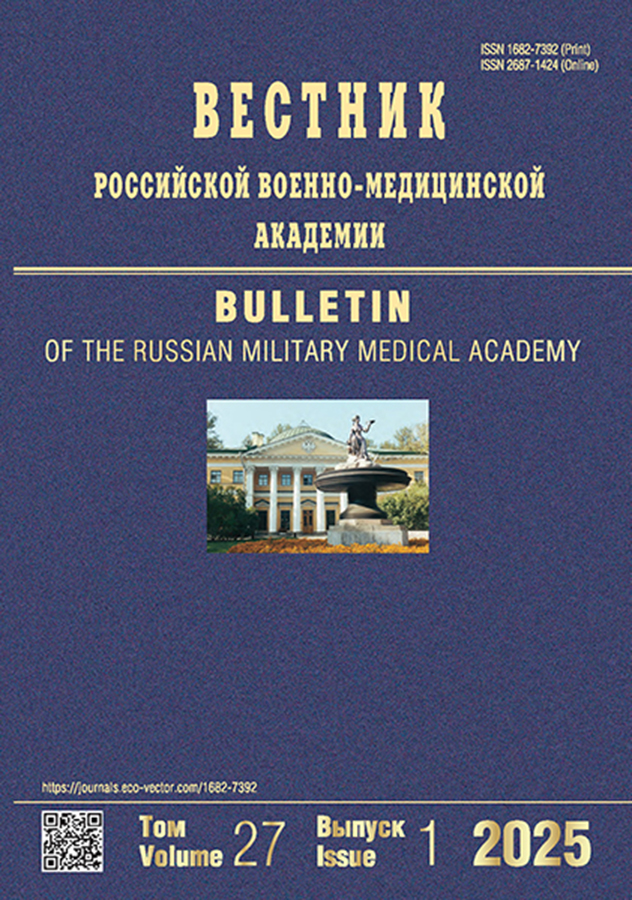Activity of microbicidal systems in polymorphonuclear neutrophils during the remediation of chemical weapon destruction sites
- 作者: Bogdanova E.G.1, Bolekhan A.V.1, Arzhavkina L.G.1,2
-
隶属关系:
- Kirov Military Medical Academy
- North-Western State Medical University named after I.I. Mechnikov
- 期: 卷 27, 编号 1 (2025)
- 页面: 59-66
- 栏目: Original Study Article
- ##submission.dateSubmitted##: 08.07.2024
- ##submission.dateAccepted##: 03.02.2025
- ##submission.datePublished##: 01.05.2025
- URL: https://journals.eco-vector.com/1682-7392/article/view/634041
- DOI: https://doi.org/10.17816/brmma634041
- ID: 634041
如何引用文章
详细
Background: The destruction of chemical weapons stored in the Russian Federation was completed in 2017. However, remediation activities at these facilities continue, including decontamination and dismantling of process equipment, rehabilitation of buildings and sites, waste disposal and burial, and land reclamation within and around the former chemical weapon destruction facilities. Upon completion of these phases, the facilities will be subject to re-profiling or complete liquidation.
Aim: The aim of the study was to examine the nonspecific immune defense of military personnel engaged in remediation activities at hazardous chemical facilities.
Materials and methods: This study examined the nonspecific immunity of military personnel engaged in the remediation of chemical weapon destruction facilities at Kizner, Maradykovsky, and Leonidovka. Long-term exposure to hazardous chemicals was found to induce functional impairments in polymorphonuclear neutrophils, exhibiting a phased response pattern.
Results: The oxygen-dependent microbicidal activity of neutrophils, assessed using the nitroblue tetrazolium test, was significantly lower than both the control group values and standard reference ranges, regardless of occupational roles. This indicates a functional deficiency in neutrophils and their impaired activation, possibly due to environmental and occupational stress affecting this component of the immune system. Conversely, the oxygen-independent microbicidal activity, assessed using the lysosomal-cationic test, demonstrated consistent tolerance to adverse chemical factors. Assessment of neutrophil phagocytic activity in response to Staphylococcus aureus revealed a significant decrease in the number of cells capable of engulfing foreign agents compared to the control group, whereas their functional capacity remained preserved. The proportion of phagocytic cells was not associated with the degree of exposure to toxic substances.
The leukocyte migration inhibition test showed functional impairments in immunocompetent cells, indicating maladaptation, which was notable in personnel with direct exposure to toxic agents. Data from the period of active operation of chemical weapon destruction facilities exhibited no improvement in immune function markers.
Conclusions: This indicates that chemical disposal operations and remediation activities at hazardous facilities place a significant strain on the immune system. This requires continued monitoring with the integration of immunological surveillance into the medical support system for personnel working at hazardous chemical facilities.
全文:
作者简介
Elena G. Bogdanova
Kirov Military Medical Academy
编辑信件的主要联系方式.
Email: vmeda-nio@mil.ru
ORCID iD: 0000-0003-3054-0641
SPIN 代码: 7726-8614
Cand. Sci. (Biology)
俄罗斯联邦, Saint PetersburgAnna V. Bolekhan
Kirov Military Medical Academy
Email: vmeda-nio@mil.ru
ORCID iD: 0000-0002-1301-348X
SPIN 代码: 5182-8600
Cand. Sci. (Biology)
俄罗斯联邦, Saint PetersburgLeila G. Arzhavkina
Kirov Military Medical Academy; North-Western State Medical University named after I.I. Mechnikov
Email: vmeda-nio@mil.ru
ORCID iD: 0000-0001-5198-874X
SPIN 代码: 8359-4200
Cand. Sci. (Biology)
俄罗斯联邦, Saint Petersburg; Saint Petersburg参考
- Gofman VR, Kalinina NM, Ketlinskiy SA. Immunodeficiency states. Saint Petersburg: Folio; 2000. 568 p. (In Russ.) EDN: WQEUPE
- Petlenko SV, Ivanov MB, Goverdovsky YuB, et al. Adaptive immune response of people living near chemically hazardous object. Military Medical Journal. 2011;332(10):15–23. EDN: ROBOBH
- Bogdanova EG, Petlenko SV, Nacharova EP, et al. With a range of non-specific protection mechanisms in persons, working on food products and chemical products. Medical immunology. 2006;8(2–3):364–365. (In Russ.)
- Petlenko SV, Goverdovsky YuB, Bogdanova EG., et al. Changes in structural and functional condition of cellular immunity at influence of a complex of factors of objects of storage of the chemical weapon. Bulletin of the Russian Military Medical Academy. 2011;(3):91–98. EDN: OILBVT
- Efimova EL, Yanno LV, Prokhorenko OA, et al. Features of the immunological reactivity of personnel for the destruction of chemical weapons. Emergency medicine. 2018;20(S3):494–501. EDN: YPHKTR
- Efimova EL, Yanno LV, Prokhorenko OA, et al. Assessment of the results of examination of the immune reactivity of the personnel of chemical weapons destruction facilities at the decommissioning stage. Emergency medicine. 2019;21(3):416–428. EDN: GDJFTD
- Filatov BN, Britanov NG, Klaucek VV, et al. Hygienic aspects of reclamation of the site of the former mustard gas, lewisite and lewisitemustard-gas mixtures production plant. Theoretical and applied ecology. 2012;(4):48–51. EDN: PYFYUV
补充文件







